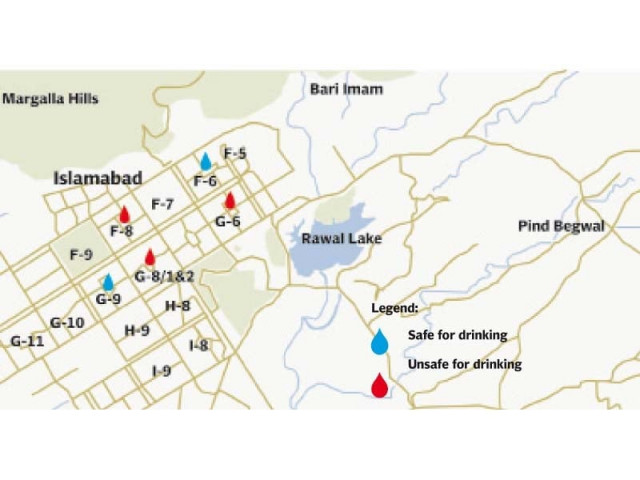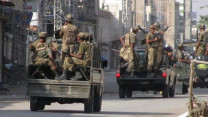The ‘un’-filtration plants
Of 37 water filtration plants in the city, most are dysfunctional or providing unhygienic water.

Water is one of life’s essential requirements. Ignore it, and life will cease to exist. City managers, unfortunately, have been doing just that by ignoring the supply and quality of water made available to the nation’s capital, Islamabad, and its nearly two million residents.
The city’s populace now faces a dearth of over 20 million gallons of water every day.
Why?
“Less rain, shrinking water resources, water wastage courtesy of the almost dead water supply pipelines and a steadily increasing city population over the past few years are all contributing to water scarcity,” said Pakistan Council for Research on Water Resources (PCRWR) spokesperson Lubna Naheed.
The city’s water managers, however, seem least bothered as no visible efforts to enhance water resources or replace the decrepit water supply system have been made for decades.
Shortages aside, the Capital Development Authority’s (CDA) water management department has also failed to ensure that the limited water available is safe for human consumption. A recent survey conducted by The Express Tribune showed that the water that has purportedly gone through filtration plants and is being supplied to residential areas through pipelines in several areas is not fit for drinking. Most of the water samples taken contained potentially dangerous microorganisms. The same applied for a number of so-called ‘safe’ tube wells that rely on boring.
Black water
Water is supposed to be transparent. Would you drink a glass of black liquid if you were told it is water? The evidence would suggest that, unknowingly, you already have.
The Express Tribune collected water samples from different locations around the city to test them for microorganisms using specialised self-test kits available from the PCRWR laboratory.
The procedure required keeping the water samples in special chemical vials for 48 hours. If the samples did not change colour, the water was safe, and if it turned black, the contents were not fit for drinking. Out of nine samples collected, five turned black.
Seven filtration plants were also tested. Four of them were found fit for drinking, namely the filtration plants in Sectors G-9/3, G-9/2 and F-6/1, and the one in Margalla Town. Those found unfit were located at the district courts in Sector F-8, Aabpara Market, and one in the old office of the senior superintendent of police (SSP) in Sector F-8. This office was recently shifted to Sector G-11 but the plant is still there, regularly used by court and private employees from the area.
“Every day, two to three police officials take sick leave. Most of them cite stomach problems as the reasons,” said a Margalla police constable deployed at the district courts. For him, the survey’s findings were not a surprise, but just a confirmation. “The water [at the district courts] always smells weird, but we have no choice but to drink it,” he added.
The residential sector G-8 is perceived as being better managed for both water and power.
However, tests carried out on water supplied via the main lines and also at a bored tube well in Sector G-8/2 showed that the perception is false. Meanwhile, the filtration points in sectors G-8/1 and G-8/2 were both out of order.
“In any case, most people here use the tube wells. I personally do not prefer filtration plants. They do not look clean,” said Aftab Karim, a resident of Sector G-8/2 who was filling a small water container from a tube well adjacent to the filtration plant. He said he also makes sure to boil the water before using it for drinking.
Maqsood Akhtar, a resident of Sector G-9/4, also preferred the tube well adjacent to the G-9/3 filtration plant. “Do you think water from this plant is clean? I don’t take risks with my family’s health,” he replied, when asked why he did not use the filtration plant that was in working condition.
However, he complained of long queues at the tube well and was hopeful that the authorities would ensure the filtration plants provide clean, drinkable water. If not, “at least they should look clean”, Akhtar demanded.
Where the germs come from?
Contamination starts from the head of the water supply chain, the water reservoirs. Simly, Rawal and Khanpur dams are the three main water supply sources for Islamabad and Rawalpindi. Given the amount of flora and fauna that interact with the water as it makes its way into the reservoirs, the water there is understandably not safe from contamination.
The water is filtered at certain points between the dams and the chain of pipelines before entering the water supply system, but the results above would not suggest so.
A PCRWR official said, “Sometimes people tell us they saw animal corpses in the dams and the water tanks at filtration plants including Sangjani, [which is shared by the twin cities].”
The official added that water storage tanks at such plants were not regularly chlorinated by the authorities responsible for their maintenance.
Moreover, city’s water supply pipelines are all in their original condition. They have not been replaced since they were first laid at the time the city was established. “More than 60 per cent of these lines are now suffering from seepage and leakage,” said the PCRWR official, adding that seepage could compromise the quality of most household water supply.
“The lines have required massive repairs and in some cases, replacement, for years, but they are still being used,” the PCRWR said. The official added that maintenance at regular intervals could have extended their life, but they were left unattended.
The (not so) safe alternative
Not everyone can afford bottled water, yet it is consumed on a large scale in Islamabad. A recent PCRWR report found high levels of arsenic in at least ten brands of bottled water.
The quarterly report for July to September 2012 said that 67 samples of bottled water brands collected from Islamabad, Rawalpindi, Lahore, Faisalabad, Multan, Sargodha, Sialkot, Peshawar and Quetta revealed that 14 brands were unsafe due to chemical or microbiological contaminations. They included Premium Pure Water, NXT, Kallan Water, Aqua Hygienic, Standard, Kalash Pure Water, Nation, Lock, Aqua National, Active, Al-Shifa, Naimat, Natur Aqua and Irma National.
Ten of these brands (Premier Pure Water, Nation, Naimat, Natur Aqua, Kallan Water, Active, Al-Shifa, Lock, Aqua National, Kalash Pure Water) contained high levels of the carcinogen arsenic, ranging from 14 to 380 parts-per-billion (ppb), much higher than the permissible limit of 10 ppb.
Apart from the cancer risk, arsenic contamination could cause diabetes, kidney diseases, hypertension, heart diseases, and birth defects, the report said.
Five brands, the Premier Pure Water, Nation, Natur Aqua, Aqua Hygienic and Irma National, were unsafe due to high level of sodium, one brand for high level of potassium while another one was found microbiologically unsafe.
These are the brands that the PCRWR is ‘allowed’ to test. “We are not allowed to test big brands. It was banned after we once detected contamination in these brands as well. Then they used governmental channels to pressurise us and got exemptions from testing,” said a PCRWR laboratory official, asking not to be named.
The official further added that lesser-known mineral water brands just come back with different names after they are found to be unsafe and are banned. “Thorough checks and balances are required,” the official added.
Published in The Express Tribune, October 22nd, 2012.



















COMMENTS
Comments are moderated and generally will be posted if they are on-topic and not abusive.
For more information, please see our Comments FAQ